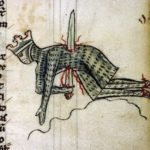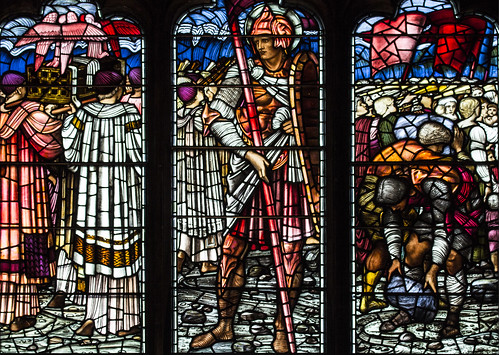We run our website the way we wished the whole internet worked: we provide high quality original content with no ads. We are funded solely by your direct support. Please consider supporting this project.
The “Third Way”: Seeing God’s Beauty in the Depth of Scripture’s Violent Portraits of God
A publishing house recently sent me an advance copy of a book written by a well known scholar on the topic of the non-violent God revealed in Jesus, asking me to endorse it. (Publishing protocol stipulates that endorsers not critique a book before it’s released, so I will not mention the name of the author or the title of this book.) This tome did an excellent job of demonstrating that non-violence was at the heart of Jesus’ revelation of God and his kingdom ethic. It also did an excellent job of demonstrating that much of the Bible paints a beautiful, peace-loving portrait of God that is more or less in line with this revelation and ethic. For these reasons, I gave the book a solid endorsement.
When it came to the question of what to do with Scripture’s violent portraits of God, however, the author was, in my opinion, not so helpful. He basically argued that we simply have to decide which conception of God we’re going to believe while offering a number of reasons why we should prefer the non-violent conception of God. This is what I consistently find among authors who grasp how important non-violence is for Jesus’ revelation of God and for his kingdom ethic. In my forthcoming book, The Crucifixion of the Warrior God, I label this “The Dismissal Solution,” for it presumes that the way to “solve” the problem of violent divine portraits of God in Scripture is to dismiss them.[1]
There are a number of formidable problems this “solution” faces, but for right now it must suffice to mention only two. First, if we assume that we must dismiss Scripture’s violent portraits of God to solve this problem, we are going to find that we will have to dismiss a great deal of the Bible! In fact, once you subtract divine acts of violence and divinely sanctioned violence from the biblical narrative, it is not clear that any coherent narrative remains! As much as we might wish it were not so, there is simply no way to deny that the OT narrative is largely structured around episodes of divine violence.
Second, while I hesitate to agree with Jenkins when he claims that this “approach… makes nonsense of any claims to biblical infallibility,” I would argue that it is at least in tension with the Church’s traditional conception of biblical authority.[2] Based on the precedent set by Jesus and the NT authors, the Church has always confessed that all canonical writings are “breathed” by God (2 Tim.3:16). And while the Church has always been open to people interpreting Scripture in a variety of ways, it has also always understood biblical inspiration to at least rule out the option of simply dismissing any portion of Scripture. As Karl Barth argued, the traditional confession of biblical authority means that, if it’s in Scripture, we have no choice but to wrestle with it as God’s Word.[3]
Unfortunately, to date, the only other option offered people has been to simply accept the violent portraits of God as authoritative. In my forthcoming book I label this approach “the Synthesis Solution,” for it requires people to synthesize the violent divine portraits in Scripture with the revelation of God in Christ. People thus develop a composite portrait of God that combines (say) the portraits of God commanding genocide, smashing parents and children together and causing parents to cannibalize their children with the enemy-embracing, self-sacrificial God of love revealed in the crucified Christ.
In my opinion, this approach is even less viable for followers of Jesus than the Dismissal Solution.[4] There are a host of problems with this view, but the only one I will mention now is that the NT consistent depicts Jesus not as one revelation among others, but as the definitive revelation that trumps all others. Throughout the NT we find authors placing the revelation of God in Christ – and especially the crucified Christ – above all that we find in the OT.[5] The conviction that the crucified Christ culminates and supersedes all that came before him is reflected, for example, when John defines God as love (12 Jn 4:8) while pointing to the cross as the way we are to define love (I Jn 3:16). It’s reflected as well in Jesus’ unprecedented claim that “whoever sees me sees the Father” (Jn.14:9) as well as in his breathtaking claim that all Scripture was about him (Jn.5:39-40, 45-6; Lk 24:25-27, 44-45)! And it is reflected in his outlandish claim to be the only human who truly knows the Father (Mt.11:27) as well as in his audacious replacement of the OT’s foundational principle of justice (“eye for an eye”) with his new command to love enemies and to refrain from retaliation, going so far as to render compliance with this teaching the criteria for being considered a child of God (Mt.5:38-45).
In this light, I trust it’s clear why I consider both the Synthesis and the Dismissal Solutions to be unviable for followers of Jesus. And for all who understand Jesus to reveal a non-violent God while also embracing all Scripture as God’s Word, this means we have no choice except to look for a third alternative. My claim is that this “third way” is present, at least in a seminal form, in the NT itself. As I’ve argued over the last three posts, when we explore the way the NT authors looked for and found Christ in the OT, it is apparent that they didn’t feel bound by the original meaning of verses. For example, following Matthew Bates, I’ve noted how Paul used “proposological exegesis” to discern “the voice behind the voice” in the OT, moving past “the letter” to discern “the glory of God shining in the face of Christ” in the depth of Scripture (2 Cor. 3:16-4:6). So too, the authors of the Gospels were willing to go to remarkable creative exegetical lengths to find Christ in the OT.[6] Hence, if we can neither dismiss nor embrace the OT’s violent divine portraits, it seems to me that the precedent set by the NT itself should motivate us to try to reinterpret them.
As a matter of fact, the Church has always applied this reasoning to other aspects of Scripture. For example, from Augustine to Aquinas to Calvin up to modern times, theologians have been willing to significantly reinterpret large portions of Scripture to get it to conform to the classical model of God as atemporal (“above” time), impassible (“above” suffering and passion) and immutable (“above” all change).[7] Given that the God of Scripture is uniformly depicted as interacting with us in time, as suffering a great deal (e.g. the cross!) and as being deeply affected by us, to the point of changing his plans, this is no small feat! In fact, prior to the Constantinian revolution in the fourth and fifth centuries AD, theologians such as Origen, Gregory of Nyssa and John Cassian saw that Scripture’s violent portraits of God conflicted with the revelation we have in Christ and applied this reinterpreting approach to resolve this dilemma. Unfortunately, this “third way” of handling violent portraits of God stopped being explored once the Church embraced the power of the State, not because the interpretations of these theologians was deemed implausible, but because it was deemed no longer necessary. In fact, far from being troubled by them, the portraits of God commanding and engaging in violence became advantageous once the Church traded the power of the cross for the power of the sword, for these portraits established a precedent to justify and even help motivate “Christian” violence.
My conviction is that it is time for the Church to return to the “third way” of Origen, Nyssa and Cassian and to thus once again explore ways of reinterpreting the OT’s violent portraits. It’s time we become at least as concerned with reconciling Scripture with the moral character of God, revealed in Christ, as classical theologians have been with reconciling Scripture with the metaphysical attributes of God. I consider The Crucifixion of the Warrior of God to be a first proposal in this direction. But whereas Origen and others based their reinterpretations on allegorical exegesis, I am proposing our reinterpretations should be based on the cross, which I argue constitutes the thematic center of everything Jesus was about.[8]
At the center of God’s definitive revelation on the cross is the profound, paradoxical truth that God reveals his beauty by stooping to appear ugly. That is, God reveals his holy beauty by stooping out of love to bear the sin of his people, becoming our sin (2 Cor.5:21) and our curse (Gal.3:13), thereby taking on an ugly appearance that reflects their sin. When we read Scripture, therefore, we must do so with the awareness that it was “breathed” by this God and thus with the expectation that God may at times reveal his holy beauty by stooping out of his covenantal love and faithfulness for his people to appear ugly. As I attempt to demonstrate throughout my book, when we read Scripture with this cross-centered (“crucicentric”) lens, it opens our eyes to a number of things going on in Scripture that we otherwise would not see and that help confirm the validity of the crucicentric approach. And, most importantly, in keeping with Paul’s “prosopological exegesis,” this crucicentric approach allows us to hear the “voice” of the beautiful, stooping, sin-bearing God behind the surface “voice” of canonical portraits that reflect the fallen, culturally-conditioned, violent “voice” of Scripture’s human authors.
This is the heart of my proposed “third way.” We need not dismiss Scripture’s ugly portraits of God, but neither must we embrace them. If we simply keep our eyes fixed on the cross and read all Scripture through this lens, we can instead reinterpret them in ways that disclose how they, along with all Scripture, point to the crucified Christ. That is, we can discern the beauty of the true God revealed on Calvary in the depths of these ugly portraits.
Think about it! And pray for my stamina as I come down the final stretch with The Crucifixion of the Warrior God. It feels like I’m at the last quarter mile of a marathon, but it’s in knee-deep mud and I’m wearing cement blocks for shoes!
Greg Boyd
[1] I have on my shelves 29 books I’ve read that, in one way or another, advocate a non-violent God, and every one of them resolves the problem of divine violence by suggesting we must dismiss Scripture’s violent portraits of God.
[2] P.Jenkins, Laying Down The Sword: Why We Can’t Ignore the Bible’s Violent Verses (New York: HarperOne, 2011), 111. I hesitate to agree this view makes “nonsense” of biblical infallibility only because some advocates of the Dismissal Solution (e.g. Eric Seibert, Disturbing Divine Behavior) try hard to reconcile their views with biblical infallibility. I don’t think they succeed, but I don’t think their attempts are “nonsense.”
[3] K. Barth, Church Dogmatics (Edinburgh: T & T Clark, 1956), 1:2, p. 719.
[4] I say “less viable” because, for reasons I’ll now share, I consider compromising the revelation of God in Christ to be a more grievous error than dismissing portions of the OT.
[5] E.g. Heb. 1:1-3; Jn.1:17-18; 5:36; Lk.9:29-36; Lk 9:54 (cf. I Kg 1:10-12); Col.2:17 (cf. Heb.10:1); 1 Tim.2:5; 1 Jn2:22-23. In The Crucifixion of the Warrior God I spend over 50 pages demonstrating this point.
[6] Several of the works on the Christocentric way NT authors creatively interpreted the OT that I’ve found most helpful are M. Bates, The Hermeneutics of the Apostolic Proclamation: The Center of Paul’s Method of Scriptural Interpretation (Baylor University Press, 2012); R G. Goldsworthy, Christ-Centered Biblical Theology: Hermeneutical Foundation and Principles (Downers Grove: IVP Academic, 2012); N. Longenecker, Biblical Exegesis in the Apostolic Period (Grand Raids: Eerdmans, 1975); D. Dockery, Biblical Interpretation Then and Now: Contemporary Hermeneutics in the Light of the Early Church (Grand Rapids, MI: Baker, 1992); D. A. Carson, G. Beale, Commentary on the New Testament Use of the Old Testament (Grand Rapid: Baker Academic, 2007); A. Rogerson, C. Rowland, B. Lindars, The History of Christian Theology, Vol. 2. The Study and use of the Bible, ed. P. Avis, 3 vols. (Grand Rapids: Eerdmans, 1988); S. Moyise, Paul and Scripture: Studying the New Testament Use of the Old Testament (Grand Rapids: Baker Academic, 2010); E. E. Ellis “Biblical Interpretation in the New Testament Church,” in Mikra, ed. M. J. Mulder and H. Sysling, eds. Mikra (Philadelphia: Fortress, 1988), 691-725; and G. K. Beale, The Right Doctrine From the Wrong Texts? Essays on the Use of the Old Testament in the New (Grand Rapids: Baker Academic, 1994).
[7] I place “scare quotes” around “above” to alert readers to (misguided, in my view) assumption that a being who was devoid of sequence, a capacity to suffer and experience passion, and a capacity to be affected by others and change in response to others would be superior to a being who has these capacities.
[8] While I argue that a cross-centered approach to Scripture is the only means of discerning how violent divine portraits point to Christ, I’ve come to the conviction that all theological reflection should be centered on the cross and that, when this is carried through consistently, it significantly reframes every aspect of our theology while resolving a multitude of classical theological conundrums. I am thus preparing a book to follow The Crucifixion of the Warrior God that will be (tentatively) titled, The Cruciform Center: Rethinking Biblical Revelation, Interpretation and Theology in Light of the Cross.
Lawrence OP via Compfight
Related Reading

Does God Inflict Physical Disabilities?
In Exodus 4, we find Moses claiming that he could not be used by Yahweh to get the children of Israel out of Egypt because he was “slow of speech and tongue.” To this Yahweh replies, “Who gave human beings their mouths? Who makes them deaf or mute? Who gives them sight or makes them…

God’s Non-Violent Ideal in the OT
While God condescended to working within the violent-prone, fallen framework of his people in the Old Testament—as I argue in Crucifixion of the Warrior God—the OT is also full of references to how God worked to preserve his non-violent ideal as much as possible. He did this by continually reminding his people not to place…

The Cross as a Trinitarian Event
On Calvary, the all-holy God fully identified with sinners, suffering the consequences of our sin as though he himself were guilty. While God is never culpable for the evil he allows, he nevertheless assumes responsibility for it by fully identifying with those free agents who are in fact culpable. While the Son alone suffered as…

Who Rules Governments? God or Satan? Part 2
In the previous post, I raised the question of how we reconcile the fact that the Bible depicts both God and Satan as the ruler of nations, and I discussed some classical ways this has been understood. In this post I want to offer a cross-centered approach to this classical conundrum that provides us with…

Why Greg Can’t be Accused of Marcionism (Let’s Not Burn Him at the Stake Just Yet)
Kristin Brenemen via Compfight Richard Beck posted a blog today entitled It’s the Same God: On Marcionism, Creeds, Hermeneutics and War. You’re going to want to take the time to read through it in its entirety. Greg has been accused of Marcionism quite a lot as a result of the working out of his Cruciform…

Why Vegetarianism Instead of Veganism?
Greg talks about vegetarianism and veganism. http://traffic.libsyn.com/askgregboyd/Episode_0054.mp3

